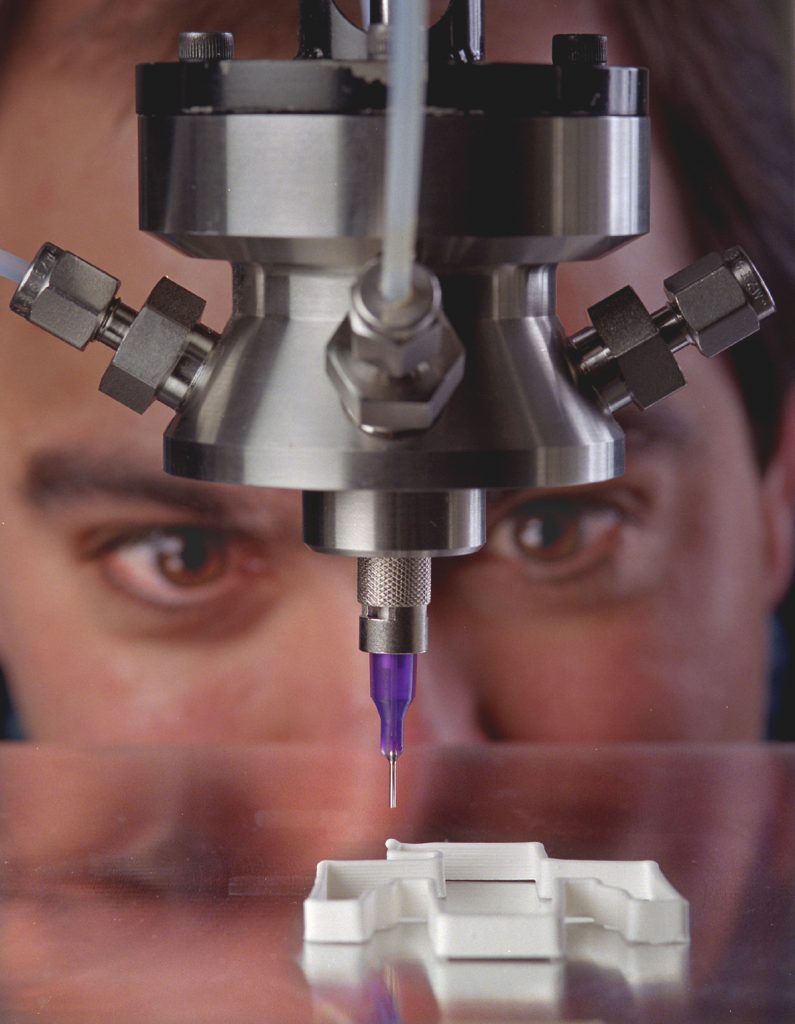
(Photo by Randy Montoya)
Download 300dpi JPEG image, ‘Robocast.jpg’, 1.9 Mb
ALBUQUERQUE, N.M. — An engineer at the U.S. Department of Energy’s Sandia National Laboratories has developed a new way to fabricate ceramics that requires no molds or machining.
Called robocasting, it relies on robotics for computer-controlled deposition of ceramic slurries — mixtures of ceramic powder, water, and trace amounts of chemical modifers — through a syringe. The material, which flows like a milkshake even though the water content is only about 15 percent, is deposited in thin sequential layers onto a heated base.
“Layer by layer the part grows before your eyes,” says Joe Cesarano, the engineer who originated the concept. “The robot squeezes the slurry out of the syringe, almost like a cake decorator, following a pattern prescribed by computer software.”
Sandia is constantly pursuing better ways to make ceramics because the materials are “very important to Sandia’s mission,” Cesarano says. Ceramics are found in products that touch just about everybody’s life. They’re in household appliances, automobiles, airplanes, computers and medical equipment and have a variety of functions ranging from structural to electrical to optical.
Bob Eagan, Sandia’s vice president for Physical Sciences and Components, says robocasting may change the future of ceramics manufacturing.
“It has the potential of giving us a tool for making ceramic parts that can’t be built today using existing methods,” he says. “Also, it may result in cheaper and faster fabrication of complex parts.”
Because the new method allows a dense ceramic part to be free-formed, dried, and baked in less than 24 hours, it is perfect for rapid prototyping. Engineers can quickly change a design of a part and physically see if it works.
More traditional ceramic fabrication methods may take weeks to go from a design to an actual part. For example, the standard dry pressing method requires ceramic powder to be compacted into a solid hunk of material, a billet. To fabricate a complicated part, the billet must be sculpted into the final shape with costly machining.
Other ceramic processing techniques, such as slip casting, gel casting, and injection molding, can yield complicated ceramic parts but require the design and manufacture of molds prior to fabrication.
Besides prototyping, Cesarano sees the new method also being used in the actual manufacturing of ceramics.
The challenge in robocasting, Cesarano says, is in the science of developing ceramic slurries that actually contain more solid than liquid but exhibit a fluidlike consistency and flow.
“By understanding the colloid science and manipulating the powder surface chemistry, we are able to make ceramic slurries that are up to 85 percent ceramic powder and 15 percent water,” Cesarano says. “The high solid content minimizes the amount of drying and shrinkage.”
The right slurry properties are also essential for rapid drying of the material. Within 10 to 15 seconds of being deposited, the slurry must dry from a fluidlike state into a solidlike state so that the next layer can be added. If the slurry is too fluid, the deposits will come out as liquid beads that spread uncontrollably. If it is too thick, deposits are like rope. With the proper consistency, each deposited bead is a rectangular cross section with relatively straight walls and flattened tops. Such a structure becomes a sound foundation upon which more layers can be deposited.
After the part is formed by layering and completely dried, it is baked in a furnace at very high temperatures so that the particles can “densify,” a process called sintering. Sintering temperatures typically range from 1,000-1,700 degrees C for two hours, depending on the specific ceramic being sintered.
Cesarano says robocasting is “no more conceptually complicated than caulking a bathtub.” The difference is that when caulking a tub, the caulking gun moves as it deposits the material. In robocasting, the syringe stays in the same position and the base moves.
Robocasting has other virtues besides requiring limited machining and no molds and being able to make complex parts in less than 24 hours.
“Unlike the more traditional methods of ceramic fabrication, this has the advantage of being able to apply more than one material at a time,” Cesarano says. “Thus, materials can be graded, for example going from a ceramic material to a metal within one part without causing structural damage.”
Another positive feature is that the technique enables discrete placement of a “fugitive” material — material that would evaporate or burn away during the baking process. This is useful for creating a part that has internal structure-cooling channels, for example.
Cesarano has been researching the new technology for about two-and-a-half years, collaborating with University of Arizona Professor Paul Calvert.
Following publication of the new technology in the April issue of Ceramic Industry, Cesarano received about 20 inquiries from companies about the new technique. He currently is working with one company, prototyping a ceramic part for use in fabricating fiber optics for advanced X-ray diffraction applications.